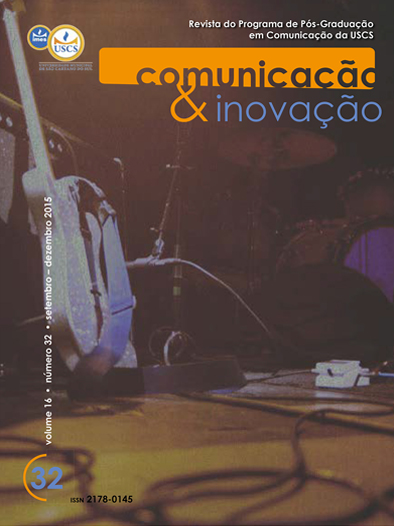A matriz de comportamento do spin doctor no processo de comunicação política
DOI:
https://doi.org/10.13037/ci.vol16n32.3279Palavras-chave:
Palavras-chave, Spin doctoring. Assessoria de imprensa. Comunicação política.Resumo
Em meados da década de 1980, surgiu nos EstadosUnidos uma nova designação para a atividade daassessoria de imprensa política: o spin doctoring.Muito se tem falado dos spin doctors e da suaforma de atuar, mas nem sempre percebemos atéque ponto as suas ações se diferenciam do modelonormativo da tradicional assessoria de imprensa.Assim, este artigo propõem-se explanar 36 técnicas,ações e comportamentos que resultam numamatriz de comportamento dessas fontes sofisticadasde informação que operam a serviço de governos,partidos políticos e até mesmo empresas privadas.
Downloads
Referências
AELST, P. V.; SHEAFER, T.; STANYER, J. The Personalization of Mediated Political Communication:
Operationalizing Key Concepts for the Analysis of News Content. In: International Communication
Association Conference. Boston: Internacional Communication Association, 2011.
AIRA FOIX, T.; PASTOR PÉREZ, L. Repensando las relaciones Política-Media. Hacia una teoría no anglosajona
de la figura del 'spin' en comunicación política. In: III Congrés Internacional de l'Associació
Espanyola d'Investigació de la Comunicació. Tarragona: Comunicació y Riesgo, 2012,
pp. 1-19.
ALTHEIDE, D. L. Creating Reality: How TV news distorts events. London: SAGE Publications, 1976.
ANDREWS, L. Spin: from tactic to tabloid. Journal of Public Affairs, v. 6, n. 1, p. 31-45, 2006. DOI: https://doi.org/10.1002/pa.37
BLUMENTHAL, S. The Permanent Campaign: Inside the world os elite political operatives. Boston:
Beacon Press, 1980.
BLUMLER, J. G. Elections, the media and the modern publicity process. In: FERGUSON, M. (Ed.). Public
Communication - The new imperatives. London and New York: SAGE Publications, 1990. pp.
101-113.
22 Comunicação & Inovação, PPGCOM/USCS
v. 16, n. 32 (7-26) set-dez 2015
Vasco Ribeiro
BROOKS, D. How to increase media coverage for your product or service by understanding and meeting
shared responsibilities with the media. Public Relations Quarterly, v. Winter (1999), p. 26-30,
1999.
BROWN, R. Rethinking government-Media relations: Towards a theory of spn. ECPR Conference.
Marburg: University of Leeds, 2003.
CRAING, J. Spinning out of control? Guardian: 33 p. 1996.
DAVIS, A. Public Relations Democracy - Public Relations, politics and mass media in Britain. Manchester:
Manchester University Press, 2002. p. 222
______. Public Relations and News Sources. In: COTTLE, S. (Ed.). News, Public Relations and Power.
London: SAGE Publications, 2003, pp. 27-42.
DAYAN, D.; KATZ, E. Media Events: The live broadcasting of history. Cambridge, London: Harvard
University Press, 1992.
ESSER, F.; REINEMANN, C.; FAN, D. Spin Doctoring in British and German Election Campaings.
European Journal of Communication, v. 15, n. 2, pp. 209-239, 2000. DOI: https://doi.org/10.1177/0267323100015002003
EWEN, S. PR! A social history of spin. New York: Basic Books, 1996.
FISHMAN, M. Manufacturing the news. Austin: University of Texas Press, 1980.
FITZWATER, M. Call the Briefing! Reagan and Bush: A decade with presidents and the press.
Massachusetts: Adams Media Corporation, 1995.
FRANKLIN, B. A good day to bury bad news? Journalists, sources and the packaing of politics. In:
COTTLE, S. (Ed.). News, Public Relations and Power. London: SAGE Publications, 2003, pp. DOI: https://doi.org/10.4135/9781446221594
45-61.
______. Packaging politics: Political communications in Britain's media democracy. London: Arnold,
2004 [1994].
FRANKLIN, B.; AL, E. Key concepts in Public Relations. London: SAGE, 2009. DOI: https://doi.org/10.4135/9781446269084
GABER, I. Government by spin: an analysis of the process. Media, Culture & Society, v. 22, n. 4, pp. 507- DOI: https://doi.org/10.1177/016344300022004008
518, July 1, 2000.
______. Too much of a good thing: the 'problem' of political communications in a mass media democracy.
Journal of Public Affairs, v. 7, n. 3, p. 219-234, 2007. DOI: https://doi.org/10.1002/pa.266
______. The Slow Death of the Westminister lobby: collateral damage from the MPs' expenses scandal.
MECCSA Annual Conference. London School of Economics: MECCSA, 2010.
GANS, H. J. Deciding What's News: A study of CBS Evening News, NBC Nightly News, Newsweek and
Time. Evanston: Northwestern University Press, 1979.
GEWIRTZ, S.; DICKSON, M.; POWER, S. Unravelling a 'spun' policy: a case study of the constitutive
role of 'spin' in the education policy process. Journal of Education Policy, v. 19, n. 3, pp. 321-342,
2004.
23 Comunicação & Inovação, PPGCOM/USCS
v. 16, n. 32 (7-26) set-dez 2015
A matriz de comportamento do spin doctor no processo de comunicação política
GOLDING , P.; BENS, E. D.; MCQUAIL, D., Eds. Communication Theory and Research. London: SAGE
Publications ed., 2005.
GREVE, F. Journalism In the Age of Pseudoreporting. Disponível em: http://niemanreports.org/articles/
journalism-in-the-age-of-pseudoreporting/, 2005. Acessado em 24 ago. 2015.
HARRIS, P. To Spin or not to Spin that is the Question: The Emergence of Modern Political Marketing. The
Marketing Review, v. 2000, n. 1, pp. 1-19, 2000.
______. Machiavelli, political marketing and reinventing government. European Journal of Marketing, v.
35, n. 9/10, pp. 1136-1154, 2001.
HAUSER, R. Os mailings no marketing directo. Men Martins: Edições CETOP, 1999.
HESS, S. The Government/Press Connection. Washington DC: The Brookings Institution, 1984.
JAMIESON, K. H. Dirty Politics: Deception, Distraction, and Democracy. New York: Oxford Univerity
Press, 1992.
JONES, N. Doctors in the house. Guardian: 38 p. 1995.
KURTZ, H. Spin Cycle: How the white house and the media manipulate the news. New York: Touchstone,
1998.
LANGDON, J. Trust me, I'm not a doctor. Guardian: 24 p. 1995.
______. Spin, whores, spin. Guardian, p. 15, 9 August, 1996.
LOUW, E. The Media and Political Process. London: SAGE, 2005.
LOUW, E. The Media & Political Process. London: SAGE, 2010.
MAAT, H. P. How promotional language in press releases is dealt with by journalists: Genre mixing or
genre conflict? Journal of Business Communication, v. 44, n. 1, pp. 59-95, 2007. DOI: https://doi.org/10.1177/0021943606295780
MALTESE, J. A. Spin Control: The White House office of communications and the management of presidenctial
news. Chapel Hill and London: The University of North Carolina Press, 1992.
MANNING, P. News and news sources: a critical introduction. London; Thousand Oaks: Sage Publications,
2001.
______. News Sources, News Agencies and the Banking Crisis. MeCCSA Conference 2010. London School
of Economics: London School of Economics: 25 p., 2010.
MCNAIR, B. An introduction to political communication. London: Routledge, 2003 [1995]. DOI: https://doi.org/10.4324/9780203699683
______. PR must die: spin, anti-spin and political public relations in the UK, 1997-2004. Journalism
Studies, v. 5, n. 3, pp. 325-338, 2004. DOI: https://doi.org/10.1080/1461670042000246089
MENCHER, M. News Reporting and Writing. Dubeque: Wm. C. Brown Publishers, 1991 [1977].
MICHIE, D. The invisible persuaders: How britain's spin doctors manipulate the media. London: Bantam
Press, 1998.
MILLER, D.; DINAN, W. A Century of Spin: How Public Relations Became the Cutting Edge of Corporate
Power. London: Pluto, 2008.
OBORNE, P.; WALTERS, S. Alastair Campbell. London: Aurum, 2004.
24 Comunicação & Inovação, PPGCOM/USCS
v. 16, n. 32 (7-26) set-dez 2015
Vasco Ribeiro
ORNSTEIN, N.; MANN, T. The Permanent Campaign and its Future. New York: The Brookings Institute
and American Enterprise Institute, 2000.
PEARSON, M. Suppression, privacy, contempt and spin: Australia's struggle with censorship in a Wertern
democracy. 7th AMSAR. Bangkok: Bond University: pp. 1-17, 2009. DOI: https://doi.org/10.1515/9780791478950-003
PRESTON, P. Sinister conspiracy theories falling into a flat spin. Guardian: 7 p. 1996.
______. Party free or party pris? Guardian: 28 p. 1997.
RESTON, J. Washington: An anti-Hokum campaign in 1956. The New York Times: 8 p., 1955.
______. Washington: Scientists and Statesmen - The Big Difference. The New York Times: 1961.
______. Mondale and the Democrats. The New York Times: 31 p., 1981a.
______. Washington: Whant to do about begin? The New York Times: 31 p., 1981b.
RIBEIRO, V. Fontes Sofisticadas de Informação: Análise do produto jornalístico político da imprensa
nacional diária de 1995 a 2005. Lisboa: Formal Press, 2009.
______. O Spin Doctoring em Portugal: Estudo sobre as fontes profissionais de informação que operam na
Assembleia da República. 2013. 521 (PhD). Instituto de Ciências Sociais, Universidade do Minho,
Braga. 2013.
RICHARDS, P. Be your own spin doctor: A practical guide to using the media. London: Politico's, 2005.
SABATO, L. J. Feeding frenzy: How attack journalism has transformed american politics. Baltimo:
Lanahan Publishers, Inc, 1993.
SAFIRE, W. The debate and the spin doctors. The New York Times, October 21, 1984.
SCHLESINGER, P. Open Scotland? Journalists, spin doctors and lobbyists. Edinburgh: Edinburgh
University Press, 2001.
______. Is there a crisis in British journalism? Media, Culture & Society, v. 28, n. 2, p. 299-307, 2006. DOI: https://doi.org/10.1177/0163443706061691
SCHMITZ, A. A.; KARAM, F. J. C. Os spin doctors e as fontes das notícias. Brazilian Journalism Research,
v. 9, n. 1, pp. 98-115, 2013. DOI: https://doi.org/10.1177/016146811311501307
SCHROEDER, A. Presidencial Debates: Fifty Years od High-Risk TV. New York: Columbia University
Press, 2008.
SERRANO, E. Spin doctoring e profissionalização da comunicação política. In: CORREIA, J. C.;
FERREIRA, G. B., et al (Ed.). Conceitos de Comunicação Política. Covilhã: LabCom Books,
2010. pp.91-98.
SEVIN, E.; KIMBALL, S.; KHALIL, M. Listening to President Obama: A Short Examination of Obama's
Communication Practices. American Behavioral Scientist, v. 55, n. 6, pp. 803-812, 2011. DOI: https://doi.org/10.1177/0002764211406847
SEYMOUR-URE, C. Prime ministers and the media: Issues of power and control. London: Blackwell
Publishing, 2003.
SIGAL, L. V. Reporters and officials: the organization and politics of newsmaking. Lexington: D. C. Heath,
1973.
25 Comunicação & Inovação, PPGCOM/USCS
v. 16, n. 32 (7-26) set-dez 2015 DOI: https://doi.org/10.1515/9781400870851-016
A matriz de comportamento do spin doctor no processo de comunicação política
STANYER, J. The creation of political news: Television and British party political conferences. Brighton:
Sussex Academy Press, 2001.
______. Intimate Politics. Cambridge: Polity Press, 2013.
STARK, E. Postdebate presentation of candidate schemata: The spin doctor's prescription for impression
management. 2000. (61). ProQuest Information & Learning, US.
STREET, J. Mass media, politics & democracy. Hampshire: Palgrave Macmillan, 2011. DOI: https://doi.org/10.1007/978-1-137-01555-6
SUMPTER, T.; TANKARD, J. W. The spin doctor: an alternative model of public relations. Public Relations
Review, v. 20, n. 1, pp. 19-27, 1994. DOI: https://doi.org/10.1016/0363-8111(94)90111-2
TANKARD, J. W.; SUMPTER, R. Media Manipulation: The Use of the Term "Spin Doctor". Proceedings
of the Annual Meeting of the Association for Education in Journalism and Mass Communication,
Kansas City: 76th: Association for Education in Journalism and Mass Communication. 1993.
pp.4-19.
THOMPSON, J. B. Political Scandal: Power and Visibility in the Media Age. Cambridge, UK: Polity, 2000.
TRAQUINA, N. As notícias. In: TRAQUINA, N. (Ed.). Jornalismo: Questões, Teorias e "Estórias".
Lisboa: Vega, 1993a. pp.167-176.
______. Jornalismo: Questões, teorias e "estórias". Lisboa: Vega, 1993b.
TUCHMAN, G. Making news: a study in the construction of reality. New York: Free Press, 1978.
TUNSTALL, J. The Westminster Lobby Correspondents: Sociological Study Of National Political
Journalism. London: Routledge & Kegan Paul, 1970.
______. Journalists at work. Specialist correspondents: their news organizations, news sources, and competitor-
colleagues. London: Sage Publications, 1974.
VILLAFAÑE, J. Imagem positiva. Lisboa: Sílabo, 1993.
WHITE, M. Making a name in politics. Guardian: 39 p. 1996.
YANTAO, B. Interpretation of "spin doctoring". International Journal of Humanities and Social Science,
v. 2, n. 5, pp. 123-126, March, 2012. DOI: https://doi.org/10.5771/9780810879133-123
Downloads
Publicado
Edição
Seção
Licença
Direitos autorais (c) 2015 Vasco Ribeiro

Este trabalho está licenciado sob uma licença Creative Commons Attribution-NonCommercial-NoDerivatives 4.0 International License.
Conforme consta nas normas da revista, o envio de artigos e textos solicitando a apreciação com a finalidade de publicação na Comunicação & Inovação, configura a cessão de direitos autorais.
No caso de fotos e imagens, o autor deve providenciar documento que ateste a permissão em termos de direitos autorais.





